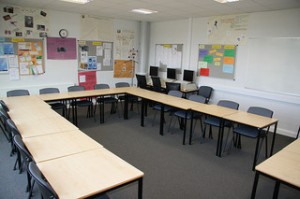by Nick Yaremchuk, Teacher, The International High School, VIU

More and more teachers that I talk to are considering how seating arrangements in their classrooms affect their teaching, affect their students’ learning, and affect discourse in their classrooms. For many educators, gone are the days of straight rows of desks with students facing the front of the room and only making eye contact with their teachers. Most professionals carefully consider how their classroom set-up will impact the educational environment. The question I have considered for years is ―What is the best seating arrangement in a classroom? The answer I keep coming back to is ―One that changes!
Changing seating arrangements is one of the simplest things a teacher can do to make the classroom experience fresh for learners. If you like the idea of increased interaction in your classroom and you want your students to interact positively and productively with you and each other, THEY NEED TO SEE EACH OTHER!
My most favored seating plan (used about fifty percent of the time) is the horseshoe or semi-circle. With a reasonable number of students in a classroom, this seating arrangement:
- Allows the teacher to see all of their students’ facial expressions and body language
- Allows the teacher to hear all of their students’ comments (at no point are there people in between the teacher and the students)
- Allows students to hear and see each other
- Allows all students to clearly see a teacher’s role modeling
- Allows all students to see the board and/or projector at the front of the room
Conversely, I use the traditional seating pattern for approximately 1/3 of my classes – for tests and quizzes, there is no better arrangement. This pattern allows teachers to see immediately when students are looking anywhere but at their own papers, and the clean rows are orderly and keep the students mindful that something important is happening in the classroom. When my students walk in and see perfect rows, they are pretty sure a pop quiz is coming. Furthermore, when students aren’t behaving properly, the traditional seating pattern is also an effective classroom management tool.
You can send students messages with the seating pattern you choose. Similar to my students understanding that straight rows mean a quiz, they also know that “clusters” (small groupings of 4 – 6 learners) mean group work. I use clusters for certain group work activities approximately one out of every 10 classes. I have found that going from a traditional seating arrangement to clusters in the middle of a class is a great way to reward some focused work that has occurred. Conversely, if the students aren’t being productive in clusters, a quick change back to rows is an indirect way of telling them that they may not sit with their classmates when unfocused.
Think of your classroom as a theater – of course, the plot and the characters are important components; but, like a good play, a varied and well-designed set can greatly enhance the experience. Remember that classroom seating arrangements don’t have to be perfect, they simply need to be considered and modified. After all, you are the director and the set designer in this theater and if you are creative with your use of space and with your designs, the audience will be captivated.
Photo by James F. Clay http://www.flickr.com/photos/jamesclay/3509154283/sizes/n/